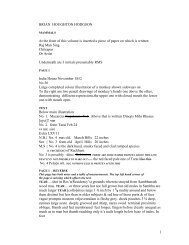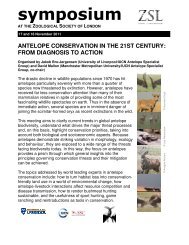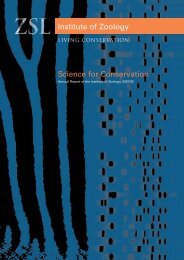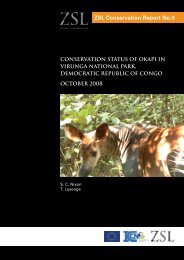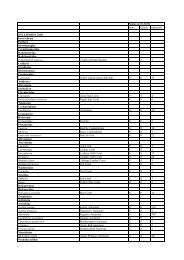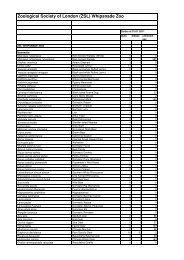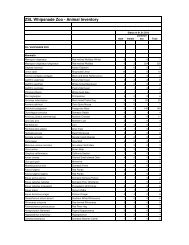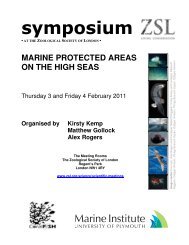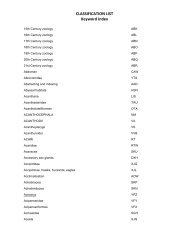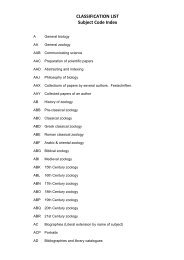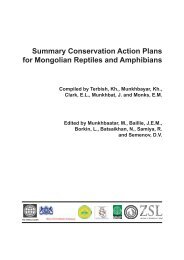Mongolian Red List of Reptiles and Amphibians - Web - Zoological ...
Mongolian Red List of Reptiles and Amphibians - Web - Zoological ...
Mongolian Red List of Reptiles and Amphibians - Web - Zoological ...
You also want an ePaper? Increase the reach of your titles
YUMPU automatically turns print PDFs into web optimized ePapers that Google loves.
Global distribution: Kazakhstan; Uzbekistan; China;<br />
Mongolia; Kyrgyzstan; possibly Afghanistan <strong>and</strong><br />
Tajikistan (IUCN, 2007).<br />
Regional distribution: Meadows, marshes, pond banks,<br />
streams <strong>and</strong> rivers in mountain-steppe, oases, <strong>and</strong> desert<br />
habitats (Munkhbayar <strong>and</strong> Terbish, 1997). Hovd in the<br />
Mongol Altai Mountain Range in western Mongolia<br />
(Borkin et al., 1986; Borkin et al., 2001), southern<br />
Mongol Altai Mountain Range <strong>and</strong> eastern Dzungarian<br />
Govi Desert (Borkin <strong>and</strong> Kuzmin, 1988; Semenov <strong>and</strong><br />
Munkhbayar, 1996; Terbish et al., 2006). It is also found in the watersheds <strong>of</strong> the Bulgan,<br />
Uliastai, <strong>and</strong> Uyench rivers, <strong>and</strong> in oases in Western Gobi. Its distribution in Mongolia is<br />
sporadic <strong>and</strong> confi ned to water bodies, therefore it <strong>of</strong>ten exists in isolated populations. Details<br />
on occurrence in each water body are available in Borkin <strong>and</strong> Kuzmin (1988). The species<br />
occurs at elevations <strong>of</strong> 1,150-2,000 metres above sea level in Mongolia (Borkin et al., 1986;<br />
L. Borkin, pers. comm.). This species has an estimated extent <strong>of</strong> occurrence in Mongolia <strong>of</strong><br />
around 16,200 km 2 .<br />
Dominant threats: Water pollution through releases <strong>of</strong> domestic sewage <strong>and</strong> agricultural,<br />
industrial, <strong>and</strong> commercial waste (Kh. Terbish, pers. comm.). Resource extraction (mining) is<br />
a cause <strong>of</strong> habitat loss <strong>and</strong> pollution. Human settlements <strong>and</strong> livestock grazing near to oases<br />
are a likely source <strong>of</strong> habitat loss, as springs can be destroyed through trampling. Drying <strong>of</strong><br />
water sources <strong>and</strong> droughts also threaten this species, although it remains unclear if these<br />
represent natural environmental changes or are driven by anthropogenic activity. Intrinsic<br />
factors such as limited dispersal, low densities, <strong>and</strong> a restricted range also affect this species’<br />
future survival.<br />
3. Bufo raddei Strauch, 1876<br />
Common names: <strong>Mongolian</strong> toad, Radde’s toad,<br />
Siberian s<strong>and</strong> toad, piebald toad or Tengger desert<br />
toad (English) (Frank <strong>and</strong> Ramus, 1996); Mongol bakh<br />
(<strong>Mongolian</strong>)<br />
Subspecies in Mongolia: No subspecies are currently<br />
recognised. Further investigation may reveal the existence <strong>of</strong> subspecies, particularly amongst<br />
populations in the Gobi Desert.<br />
Synonyms: Bufo kozlovi Zarevskij (described near the southern <strong>Mongolian</strong> border along<br />
Edsin-gol River), 1924<br />
Taxonomic notes: Previously considered a member <strong>of</strong> the Bufo viridis group; a group <strong>of</strong><br />
green toads comprising two subgroups (Amphibia<strong>Web</strong>, 2006). However, the validity <strong>of</strong> Bufo<br />
raddei, <strong>and</strong> its distant position from the Bufo viridis group was confi rmed by biochemical<br />
studies (Maxson, 1981). It is considered to be more closely related to species in the Bufo bufo<br />
complex <strong>and</strong> Bufo melanostictus. However, a study on the variation <strong>of</strong> this widely distributed<br />
polymorphic species did not provide conclusive results. Further genetic studies were carried<br />
out in populations in northern Mongolia <strong>and</strong> Trans Altai Govi. The results <strong>of</strong> this study<br />
showed the species to be a diploid (2n=22, NF=44) taxa (Borkin et al., 1986).<br />
30



